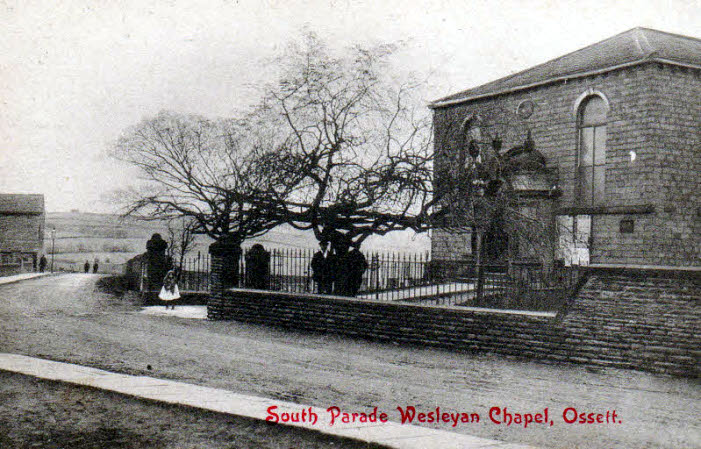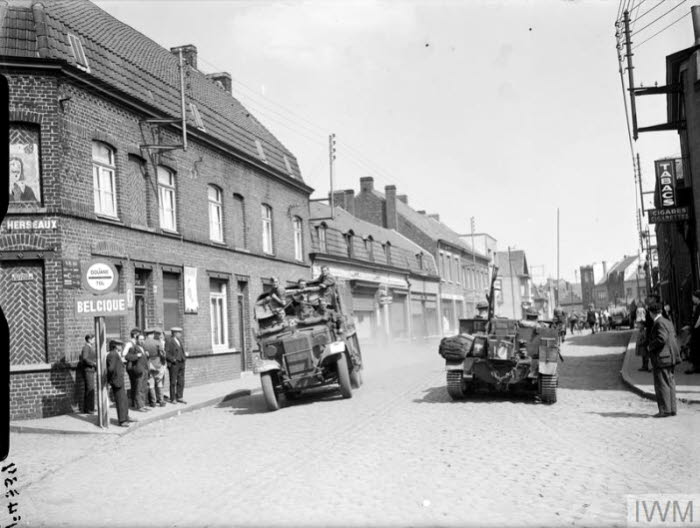
Edward O’Hare was born at Teal Street, Ossett on the 15th February 1906, the son of Wakefield born coal miner John Thomas O’Hare and Lincolnshire born Lottie Christian who married at Doncaster in July 1898.
The O’Hare family had their roots in County Down, Ireland and, in common with many other Irish families, they had journeyed to England to make a living in the early 1850’s. Edward’s great grandfather, George, a travelling draper and licensed lodging house keeper, was born in Ireland an by 1852 he had brought his family to England. In 1861 they were living at Stonegate, Wakefield and by 1871, George’s son and Edward’s grandfather, Irish born labourer John O’Hare (1850-1894), had flown the nest married and moved to Alverthorpe.
By the mid 1880s the O’Hare family, including Edward’s father, John Thomas (1872-1908), had moved again and they were living on South Parade, Ossett, close to what is now the junction with Teall Street.

Above: In 1891 the O’Hare family were living on South Parade just beyond the building on the left.
Sometime after March 1891 John Thomas must have left Ossett for the USA because on the 26th March 1895 he arrived in Liverpool from New York aboard the SS Lucania. The ship’s log records that he was a labourer amongst many other labourers and the odd carpenter, engineer and fitter who had boarded at New York.
Nine months after his return to the UK John Thomas O’Hare, a miner of South Parade, aged 23 years married 27 year-old Horbury spinster Mary Westwood at St. Peter’s Church Horbury on the 21st December 1895. Sadly, in early 1896 Mary died, aged 27 years. In summer 1898 widower John Thomas, married Lottie Christian and by 1901 he had moved further along South Parade with his new bride and they were living at Chapel Street, Ossett. Their first child, Henry Christian, was born in Ossett on 8th October 1902 and their second child, Edward, was born in Ossett on 15th February 1906.
Later that year, on the 26th September 1906, John Thomas O’Hare, a 33 year-old labourer sailed again. This time from Liverpool destined for Philadelphia and he was accompanied by his 26 year-old wife Lottie and their children Harry (Henry), aged 3 years and Edward aged 8 months. Two years later, on 31st October 1908, John Thomas O’Hare died in San Antonio de Los Moran, Ayutla, Jalisco, 350 miles west of Mexico City, leaving Lottie a widow in a small town in a foreign land with their two infant children.
It is not known when Lottie and her children returned to the UK, but it was before April 1911, for at that time the eldest son, eight year-old Henry, was living with his married aunt, Maude Goldthorpe (nee Christian) at Nooking Yard, South Parade, Ossett. Edward, aged 5 years was living at 42 Prince’s Street Doncaster with his uncle John Henry Christian and his family. The two infant children had been taken in, one by an aunt and the other by an uncle, to allow Lottie to work to earn her living.
To that effect in 1911, Lottie, and her elder sister, Lizzie Christian, were living and working as servants at The Cricketers’ Arms, Bramall Lane, Sheffield. Almost a year later the widow Lottie O’Hare married George H. Rogers on the 7th March 1912 and the couple had four children. In 1939 the family were living in Sheffield. Edward’s mother, Lottie, died there in summer 1956.
On the 26th March 1932 at the Wesleyan Chapel, Chickenley, 26 year-old coal miner Edward O’Hare married 25 year old Chickenley born, rag weaver Hilda Hunter (born 29th December 1906). Bride and groom gave their address as 186, Old Bank Road, Dewsbury. It is not known if Edward’s mother, Lottie, attended but she is not recorded as a witness to the marriage. It appears that Edward and Hilda were blessed with one child, Trevor, born 25th May 1933 (died 10th May 2010).
In 1937 Edward and Hilda were living at 16 Park Street Horbury. His brother Henry Christian O’Hare was living with his wife, Edith (nee Avison) at nearby 14 Gervase Street. In 1939 Hilda was living at 16 Park Street, Horbury with their child, Trevor. The 1939 Register was taken on 29th September 1939 and Edward is not recorded in the household, suggesting that he had already enlisted by that time. It seems likely that he was already in France.
Edward O’Hare died, aged 35 years, on the 23rd May 1941 at the Ministry of Pensions Hospital, Leeds. Edward’s address was 16, Park Street, Horbury and his occupation was given as Army Pensioner (Railway Wagon Lifter). The cause of death was Due to War Operations and his wife, Hilda, was present at his death.
The Ministry of Pensions Hospital at Chapel Allerton, Leeds opened as a hospital specialising in the fitting of appliances and false limbs to war veterans. It had five wards. The Hospital was opened in May 1927 by HRH Princess Mary and run by the Ministry of Pensions. It had two hundred beds and catered for former military personnel who had been injured in the Great War. Its patients came from Yorkshire, East Lancashire, Lincolnshire, Derbyshire and Nottinghamshire. It replaced the old military hospital at Becketts Park in Leeds. There were two theatres, and x-ray department, massage and electrical department and a bacteriological library. Officers and men had separate wards. With the start of the second world war, the hospital was expanded and eighteen wards were opened in 1940. The hospital passed from the Ministry of Pensions to the Ministry of Health in 1953.
Little is known of Edward’s war service except that he served as Private 4609639 in the 1st battalion Duke of Wellington’s (West Riding Regiment). On the day Britain declared war on Germany, Parliament introduced the National Service (Armed Forces) Act which imposed conscription on all males aged between 18 and 41 who had to register for service.
WWII was declared on the 3rd September 1939, and the 1st Battalion Duke of Wellington’s Regiment was sent to France on the 25th September 1939 as part of the 3rd Infantry Brigade of the 1st Infantry Division of 1st Corps of the British Expeditionary Force (BEF).
The 3rd Brigade remained in France, serving alongside the French Army on the Maginot Line on the Franco-Belgian border until May 1940 when the German Army invaded Holland, Belgium and France. During the fighting the BEF was forced to retreat to Dunkirk where the 3rd Brigade was evacuated to England arriving on the 1st June 1940.
This suggests that Private Edward O’Hare served overseas between 25th September 1939 and 1st June 1940. There is evidence that Edward was shot by a Belgian and brought home to a hospital in Leeds where he died from his injuries.
If indeed Edward was shot by a Belgian, and there is no reason to doubt this, it is possible that Edward may have incurred his wounds almost a year earlier than his death in May 1941. It was between 10th and 28th May 1940 that the Battle of Belgium was fought and it ended with the German occupation of Belgium following the surrender of the Belgian Army. The British Expeditionary Force, including Edward’s regiment, gave support in the Battle of Belgium.

Above: Carriers and trucks move through Herseaux, as the BEF crosses the border into Belgium, 10th May 1940. Photograph courtesy of IWM.
Following the successful offensives by Hitler’s Germany in Belgium, Netherlands and France, the War Office made the decision to evacuate British forces on the 25th May 1940. This became known as the Dunkirk Evacuation or Operation Dynamo. In the nine days from the 27 May to the 4th June 1940, 338,226 men escaped, including 139,997 French, Polish, and Belgian troops, together with a small number of Dutch soldiers, aboard 861 vessels (of which 243 were sunk during the operation).
Private Edward O’Hare died in The Ministry of Pensions Hospital, Leeds on 23rd May 1941 and is buried at Horbury Cemetery in Sec. G, Grave 512. Edward’s wife Hilda died in late 1971 aged 65 years. Between 2003 and his death in 2010, Edward and Hilda’s only child, Trevor O’Hare was living at 26 Victoria Street Horbury.
References: